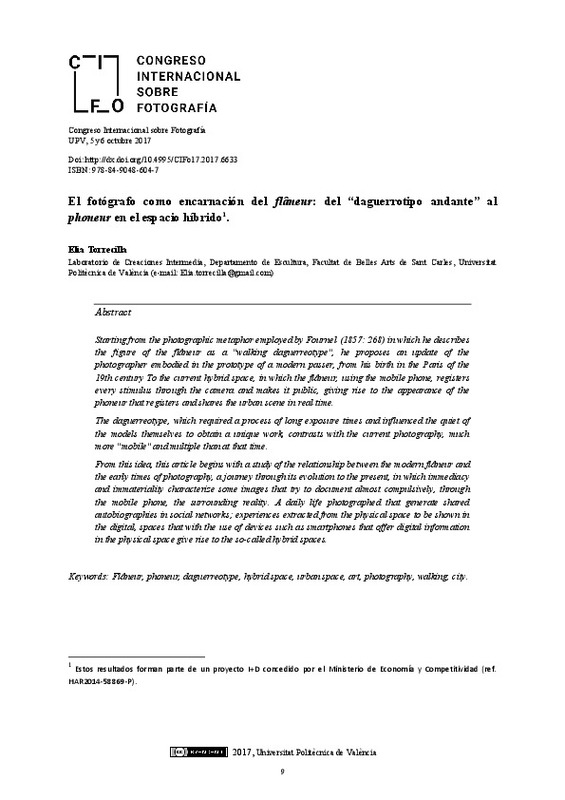JavaScript is disabled for your browser. Some features of this site may not work without it.
Buscar en RiuNet
Listar
Mi cuenta
Estadísticas
Ayuda RiuNet
Admin. UPV
El fotógrafo como encarnación del flâneur: del “daguerrotipo andante” al phoneur en el espacio híbrido
Mostrar el registro sencillo del ítem
Ficheros en el ítem
| dc.contributor.author | Torrecilla Patiño, Elia
|
es_ES |
| dc.date.accessioned | 2019-01-08T08:12:05Z | |
| dc.date.available | 2019-01-08T08:12:05Z | |
| dc.date.issued | 2018-03-14 | |
| dc.identifier.isbn | 9788490486047 | |
| dc.identifier.uri | http://hdl.handle.net/10251/114843 | |
| dc.description.abstract | [EN] Starting from the photographic metaphor employed by Fournel (1857: 268) in which he describes the figure of the flâneur as a "walking daguerreotype", he proposes an update of the photographer embodied in the prototype of a modern passer, from his birth in the Paris of the 19th century To the current hybrid space, in which the flâneur, using the mobile phone, registers every stimulus through the camera and makes it public, giving rise to the appearance of the phoneur that registers and shares the urban scene in real time. The daguerreotype, which required a process of long exposure times and influenced the quiet of the models themselves to obtain a unique work, contrasts with the current photography, much more "mobile" and multiple than at that time. From this idea, this article begins with a study of the relationship between the modern flâneur and the early times of photography, a journey through its evolution to the present, in which immediacy and immateriality characterize some images that try to document almost compulsively, through the mobile phone, the surrounding reality. A daily life photographed that generate shared autobiographies in social networks; experiences extracted from the physical space to be shown in the digital, spaces that with the use of devices such as smartphones that offer digital information in the physical space give rise to the so-called hybrid spaces. | es_ES |
| dc.description.abstract | [ES] Partiendo de la metáfora fotográfica empleada por Fournel en 1857 en la que describe la figura del flâneur como “daguerrotipo andante”, se propone una actualización del fotógrafo encarnado en el prototipo de paseante moderno, desde su nacimiento en el París del siglo XIX hasta el espacio híbrido actual. Espacios en los que el flâneur, haciendo uso del teléfono móvil, registra cada estímulo a través de la cámara fotográfica y la hace pública, dando lugar a la aparición de un flâneur actualizado que registra y comparte la escena urbana en tiempo real. El daguerrotipo, del que no se podía obtener copias y que requería un proceso de largos tiempos de exposición, y que influía en la quietud de los propios modelos para la obtención de una obra única, contrasta con la fotografía actual, mucho más “móvil” y múltiple que entonces. A partir de esta idea, este artículo comienza con un estudio de la relación que existe entre el flâneur moderno y los primeros tiempos de la fotografía, para plantear un recorrido por su evolución hasta la actualidad, en la que la inmediatez y la inmaterialidad caracterizan a unas imágenes que tratan de documentar, casi de manera compulsiva a través del teléfono móvil, la realidad circundante. Una cotidianidad fotografiada que generan autobiografías compartidas en las redes sociales; experiencias extraídas del espacio físico para ser mostradas en el digital; espacios que con el uso de dispositivos como los smartphones que ofrecen información digital en el espacio físico, dan lugar a la aparición de los denominados espacios híbridos. | es_ES |
| dc.description.sponsorship | Estos resultados forman parte de un proyecto I+D concedido por el Ministerio de Economía y Competitividad (ref. HAR2014-58869-P). | es_ES |
| dc.format.extent | 14 | es_ES |
| dc.language | Español | es_ES |
| dc.publisher | Editorial Universitat Politècnica de València | es_ES |
| dc.relation.ispartof | I Congreso Internacional sobre fotografía. Nuevas propuestas en investigación y docencia de la fotografía | es_ES |
| dc.rights | Reconocimiento - No comercial - Sin obra derivada (by-nc-nd) | es_ES |
| dc.subject | Fotografía; Docencia; Investigación; Creación Fotográfica | es_ES |
| dc.subject | Flâneur | es_ES |
| dc.subject | Phoneur | es_ES |
| dc.subject | Daguerrotipo | es_ES |
| dc.subject | Espacio híbrido | es_ES |
| dc.subject | Espacio urbano | es_ES |
| dc.subject | Arte | es_ES |
| dc.subject | Fotografía | es_ES |
| dc.subject | Caminar | es_ES |
| dc.subject | Ciudad | es_ES |
| dc.title | El fotógrafo como encarnación del flâneur: del “daguerrotipo andante” al phoneur en el espacio híbrido | es_ES |
| dc.type | Capítulo de libro | es_ES |
| dc.type | Comunicación en congreso | es_ES |
| dc.identifier.doi | 10.4995/CIFo17.2017.6633 | |
| dc.relation.projectID | info:eu-repo/grantAgreement/MINECO//HAR2014-58869-P/ES/RECUPERACION DE PRACTICAS PIONERAS DEL ARTE DE ACCION DE LA VANGUARDIA HISTORICA ESPAÑOLA Y SU CONTRIBUCION A LA HISTORIA DE LA PERFORMANCE EUROPEA/ | es_ES |
| dc.rights.accessRights | Abierto | es_ES |
| dc.description.bibliographicCitation | Torrecilla Patiño, E. (2018). El fotógrafo como encarnación del flâneur: del “daguerrotipo andante” al phoneur en el espacio híbrido. En I Congreso Internacional sobre fotografía. Nuevas propuestas en investigación y docencia de la fotografía. Editorial Universitat Politècnica de València. 9-22. https://doi.org/10.4995/CIFo17.2017.6633 | es_ES |
| dc.description.accrualMethod | OCS | es_ES |
| dc.relation.conferencename | I Congreso Internacional sobre Fotografia: Nuevas propuestas en Investigacion y Docencia de la Fotografia | es_ES |
| dc.relation.conferencedate | Octubre 31-Noviembre 01, 2017 | es_ES |
| dc.relation.conferenceplace | Valencia, Spain | es_ES |
| dc.relation.publisherversion | http://ocs.editorial.upv.es/index.php/CIFo/CIFo17/paper/view/6633 | es_ES |
| dc.description.upvformatpinicio | 9 | es_ES |
| dc.description.upvformatpfin | 22 | es_ES |
| dc.type.version | info:eu-repo/semantics/publishedVersion | es_ES |
| dc.relation.pasarela | OCS\6633 | es_ES |
| dc.contributor.funder | Ministerio de Economía y Competitividad | es_ES |








